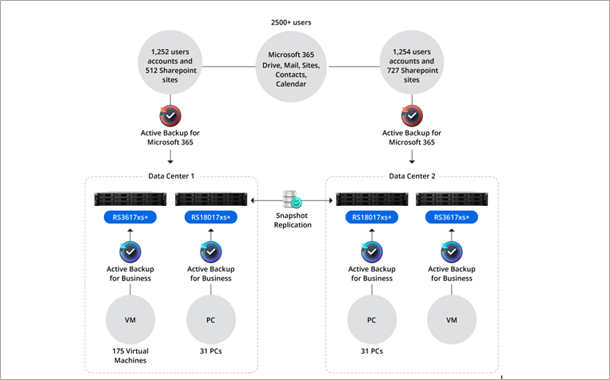Data is as valuable as currency today, and every business needs to protect it.
Hardware and software failures, data corruption, ransomware attacks, or simple accidental deletion can result in lost data, damaged reputations, and missed revenue.
The COVID-19 pandemic has brought with it even more risks to data protection.
Cybercrime has increased six times since the beginning of the pandemic, according to PurpleSec, while the FBI has been receiving up to 4,000 cybersecurity complaints each day.
In the first half of 2021, Accenture found a 125% rise in the global volume of cyber intrusion activity compared with the same period in 2020, which included targeted ransomware, extortion operations, and supply chain intrusions.

The increase in cyberthreats has spurred businesses to take precautions to keep their digital assets secure. It is now commonly acknowledged that the best data protection practices focus both on prevention and recovery.
As we enter the post-pandemic era, more challenges lie ahead. We are now at a critical crossroads where businesses must find a backup solution that provides comprehensive countermeasures.
The challenges to come in the New Normal
Skyrocketing data growth
The amount of data businesses create continues to grow. Global data consumption is forecast to reach 79 zettabytes in 2021 and over 180 zettabytes, or 180 trillion GB, by 2025. The installed base of storage capacities is also expected to increase at a compound annual growth rate of 19.2% from 2020 to 2025.
As data grows, so does the cost to store it. Coupled with the expense of scalability and backup measures for future business expansion, the costs of storing and protecting data may grow faster than many IT budgets can keep up with.
Remote and hybrid working models
Whether out of necessity or choice, many businesses are adopting remote and hybrid work models. Yet, these setups may unknowingly put data security at risk, as IT admins have less oversight and limited control over employees working in a remote setup.
From weak home networking security to unsecured endpoint devices using VPNs for remote connectivity and intranet access, these could all create vulnerabilities for cybercriminals to exploit.
Should incidents like accidental data deletion or employees falling victim to phishing campaigns happen remotely, IT support may not be as prompt.
With workloads being scattered across various employee devices and platforms in a remote working setup, IT teams may be faced with infrastructures that are difficult to manage and back up.
These challenges can lead not only to higher administration costs, but also to formidable cyberthreats to a company’s digital assets.
Compliance with legal requirements
As time spent online and data consumption surge during the pandemic, the onus on businesses to handle all this new data responsibly strengthens.
Even before the pandemic, data privacy and security were increasingly in the public eye, as concerns about how organizations use consumer data continue to mount alongside shocking stories of significant data breaches.
In response, governments have started to implement compliance regulations like the General Data Protection Regulation (GDPR) and the California Consumer Privacy Act (CCPA) to hold companies accountable and protect personal data. Businesses may be at risk of major fines if they fail to comply as a result of data breaches, unlawful storage of, or unauthorized sharing of data.
Organizations must be transparent about the customer data they store, why it is stored, and how it is secured. To remain compliant, organizations are met with the challenge of building a comprehensive data protection solution that addresses safe data storage, backup, and recovery.
Overcoming challenges and embracing the New Normal
A solid data backup and recovery plan is integral to making sure digital assets remain intact, enabling businesses to get back to normal service as seamlessly as possible in the event of disruptions or disaster.
The ideal backup and recovery solution should come with essential features that address the challenges of the New Normal and remain future-proof in the face of advancing technological landscapes.
1.Centralized management for easy deployment
A centralized backup solution can greatly reduce IT efforts. The best backup solutions offer intuitive backup management for all endpoints, including servers, virtual machines, and SaaS applications.
With one simple console, IT teams can deploy and monitor backup tasks, and stay alert with timely notifications and detailed reports.
Backups are less effective without fast and easy restoration options. Leading solutions offer near-instantaneous restoration to minimize costly service downtime. With an easy-to-use centralized backup solution, individual employees can be trusted to restore their data using flexible recovery options without burdening IT admins.
2. Maximize storage efficiency with future-proof technology
Data loss can happen at any time and in a multitude of ways. Keeping consistent backups of all devices and platforms is critical.
Considering rapidly increasing data volumes, backup procedures can have a significant impact on data and storage consumption, resulting in both longer backup wait times, higher bandwidth usage, and increased costs.
Advanced backup solutions overcome these challenges through incremental backup technology, which saves a copy only of changed or newly added files since the last backup, and data deduplication, a technology that eliminates identical data blocks across backed up workloads.
The best backup solutions offer both options while also giving attention to storage device deployment. It is essential to find a solution that is flexible and scalable enough to meet the needs of growing businesses without requiring the replacement of existing IT infrastructure.
3. Integrated solutions for cost-effectiveness
Managing business data can be time-consuming and expensive. Upfront costs, ongoing capacity upgrades, routine maintenance, integration with separate vendors, periodic firmware and software updates, repairs, and recurring license fees are just some of the prices to pay. These expenses can pile up quickly and result in an exorbitant total cost of ownership.
Having a backup service that integrates hardware and software can mitigate these costs. Some providers offer built-in backup applications that achieve full data protection, including backup tasks for physical and virtual environments, and even saving off-site copies to the cloud.
By consolidating acquisition, deployment, and technical support with one vendor, IT admins can have a comprehensive backup and recovery plan in place without paying additional license or maintenance fees.
4. Create a backup for your backups
Having one copy of your primary data is not enough to protect against the rising threat posed by cybercriminals, or to remain compliant with increasingly demanding regulations.
A good backup plan should always include a secondary backup. An ideal plan will comply with the golden 3-2-1 backup rule by creating three copies of your data on two different media, with one copy stored off-site for disaster recovery.
An example of this could be storing the production data of a video project on a PC, and creating multiple backups of that data, with one stored on the PC and another on the cloud or on an external hard drive for an extra layer of protection.
Choosing a one-stop backup solution for today’s data protection needs
Finding a solution that rises to the challenges and threats brought forward by the New Normal can be overwhelming, but that does not make it less imperative. Now is the time for businesses to up their backup game.
Businesses should consider an effective, long-term backup and recovery solution that addresses modern data challenges.
Synology NAS delivers a license-free solution that comes with centralized data protection and leverages storage efficiency.
Polish lender Idea Bank is one such business that was challenged with the legal requirement to keep backups of all operations, including emails and Microsoft SharePoint data. With data scattered over different sources, performing backup and recovery tasks took a lot of time and effort.
Business continuity was also at risk as a result of hardware failures and hard drive corruption, resulting in costly data loss and downtime for repairs.
After investing in four Synology NAS, the bank leveraged Synology’s Active Backup for Business to back up their physical and virtual Windows deployments onto two 12-bay rackmount SAS units.
A further two 12-bay Synology RackStation units were used to back up a total of 2,506 Microsoft 365 accounts and 1,239 Microsoft SharePoint sites with Active Backup for Microsoft 365. New users were also automatically detected and backed up, reducing the time spent on manual configuration.
The bare-metal and SaaS backups proved to be exactly the time-saving solution that Idea Bank needed, as their applications could be restored to their original configurations and computers were ready for use immediately after restoration.
“Synology Active Backup for Microsoft 365 has streamlined our operations. It has dramatically boosted the efficiency of our admins backing up email, SharePoint, and other data,” said Przemysław Grzegorczyk, Microsoft Systems Administrator at Idea Bank.
Not forgetting to adhere to the 3-2-1 backup rule, the bank regularly backs the data on two of the Synology NAS devices up to one another with Snapshot Replication, adding a layer of redundancy in the event that the primary backup destination is unavailable.

“Because it is license-free, we also do not have to worry about renewing subscriptions or buying additional support for the next few years,” Mr. Grzegorczyk added.
After deploying an affordable and consolidated solution, Idea Bank was able to simplify and centrally manage backup and recovery tasks with ease, protecting all their digital assets and solving their data protection challenges.
Discover how you can overcome your data protection challenges with Synology’s comprehensive backup solutions [link to this => https://sy.to/uiyre ]
Discuss your Business Backup plan with a Synology expert [link to this => https://sy.to/qics1]



















